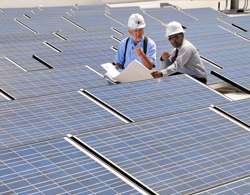New energy model offers transparency to let others replicate findings

(Phys.org) —Computer models are used to inform policy decisions about energy, but existing models are generally "black boxes" that don't show how they work, making it impossible for anyone to replicate their findings. Researchers from North Carolina State University have developed a new open-source model and are sharing the data they put into it, to allow anyone to check their work – an important advance given the environmental and economic impact of energy policy decisions.
"Most models show you the math behind how they work, but don't share the source code that is supposed to implement that math – so you can't tell how faithful the model is to the mathematics," says Dr. Joseph DeCarolis, an assistant professor of civil, construction and environmental engineering at NC State and co-author of a paper on the new model. "And the people utilizing existing models often don't share the data they use. So, in effect, you can't check their work.
"That's a problem, because the results of those models are informing policy decisions with billions of dollars on the line."
The new open-source model, called Temoa, is an energy economy optimization (EEO) model. EEO models are computer models that inform policy and industry decisions by offering insights into how energy costs and production are likely to change over time. For example, EEO models could be used to identify strategies that would drive down energy costs and reduce greenhouse gas emissions over the next 10, 20 or 30 years.
DeCarolis's team designed Temoa to be flexible, allowing users to look at any timeframe and on any scale, from a global model to a model of a single city. They also designed Temoa to be more rigorous than existing models when it comes to addressing uncertainty. Specifically, they plan to combine multiple forms of analysis to give policymakers more information on the potential impact of specific policy alternatives.
The paper, "Modeling for Insight Using Tools for Energy Model Optimization and Analysis (Temoa)," is published online in Energy Economics.
More information: Detailed information and links to the model source code and data are available at temoaproject.org
"Modeling for Insight Using Tools for Energy Model Optimization and Analysis (Temoa)" Authors: Kevin Hunter, Joseph F. DeCarolis and Sarat Sreepathi, North Carolina State University. Published: online Aug. 26, 2013 in Energy Economics, DOI: 10.1016/j.eneco.2013.07.014
Abstract: This paper introduces Tools for Energy Model Optimization and Analysis (Temoa), an open source framework for conducting energy system analysis. The core component of Temoa is an energy economy optimization (EEO) model, which minimizes the system-wide cost of energy supply by optimizing the deployment and utilization of energy technologies over a user-specified time horizon. The design of Temoa is intended to fill a unique niche within the energy modeling landscape by addressing two critical shortcomings associated with existing models: an inability to perform third party verification of published model results and the difficulty of conducting uncertainty analysis with large, complex models. Temoa leverages a modern revision control system to publicly archive model source code and data, which ensures repeatability of all published modeling work. From its initial conceptualization, Temoa was also designed for operation within a high performance computing environment to enable rigorous uncertainty analysis. We present the algebraic formulation of Temoa and conduct a verification exercise by implementing a simple test system in both Temoa and MARKAL, a widely used commercial model of the same type. In addition, a stochastic optimization of the test system is presented as a proof-of-concept application of uncertainty analysis using the Temoa framework.
Provided by North Carolina State University



















